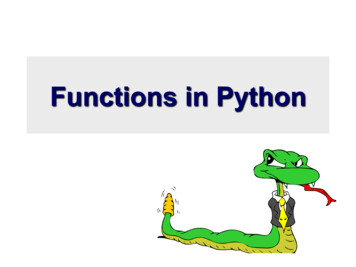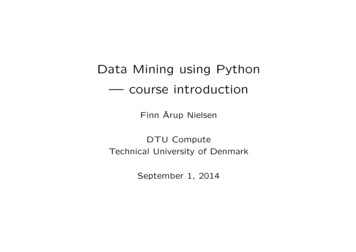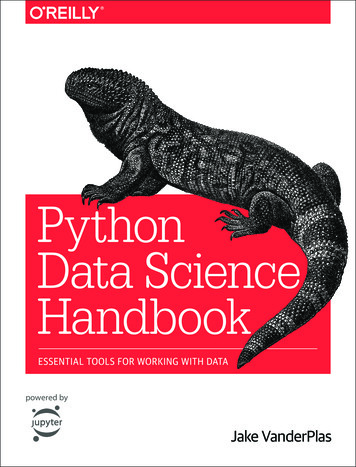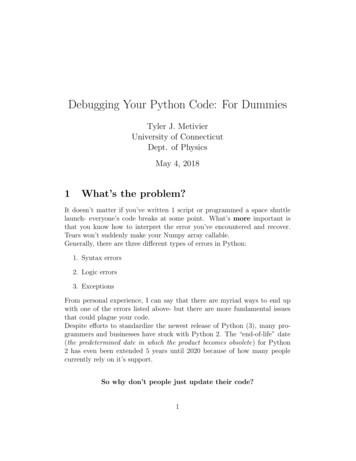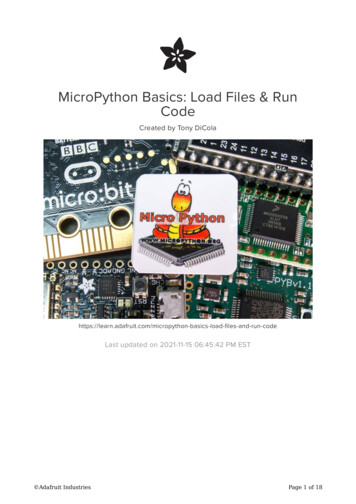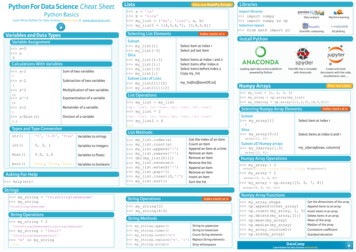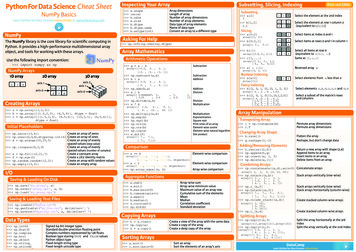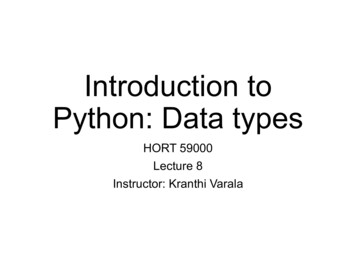
Transcription
Introduction toPython: Data typesHORT 59000Lecture 8Instructor: Kranthi Varala
Why Python? Readability and ease-of-maintenance Python focuses on well-structured easy to read code Easier to understand source code .hence easier to maintain code base Portability Scripting language hence easily portabble Python interpreter is supported on most modern OS’s Extensibility with libraries Large base of third-party libraries that greatly extendfunctionality. Eg., NumPy, SciPy etc.
Python Interpreter The system component of Python is theinterpreter. The interpreter is independent of your codeand is required to execute your code. Two major versions of interpreter are currentlyavailable: Python 2.7.X (broader support, legacy libraries) Python 3.6.X (newer features, better future support)
Python execution modelSourceCode ByteCodeExecutionby PVMInterpreter has two phases:Source code is compiled into byte codeByte code is executed on the Python Virtual MachineByte code is regenerated every time source code ORthe python version on the machine changes. Byte code generation saves repeated compilationtime.
Script vs. command line Code can be written in a python script that isinterpreted as a block. Code can also be entered into the Pythoncommand line interface. You can exit the command line with Ctrl-z onwindows and Ctrl-d on unix For complex projects use an IDE (For example,PyCharm, Jupyter notebook). PyCharm is great for single-developer projects Jupyter is great sharing code and output withmarkup
First script This is the command line interface Simply type in the command and the output, if any,is returned to the screen. May also be written as a script:
Variables and Objects Variables are the basic unit of storage for aprogram. Variables can be created and destroyed. At a hardware level, a variable is a reference to alocation in memory. Programs perform operations on variables andalter or fill in their values. Objects are higher level constructs that includeone or more variables and the set of operationsthat work on these variables. An object can therefore be considered a morecomplex variable.
Classes vs. Objects Every Object belongs to a certain class. Classes are abstract descriptions of thestructure and functions of an object. Objects are created when an instance of theclass is created by the program. For example, “Fruit” is a class while an “Apple”is an object.
What is an Object? Almost everything is an object in Python, and itbelongs to a certain class. Python is dynamically and strongly typed: Dynamic: Objects are created dynamically whenthey are initiated and assigned to a class. Strong: Operations on objects are limited by thetype of the object. Every variable you create is either a built-indata type object OR a new class you created.
Core data types Numbers Strings Lists Dictionaries Tuples Files Sets
Numbers Can be integers, decimals (fixed precision), floatingpoints (variable precision), complex numbers etc. Simple assignment creates an object of number typesuch as: a 3 b 4.56 Supports simple to complex arithmetic operators. Assignment via numeric operator also creates anumber object: c a/b a, b and c are numeric objects. Try dir(a) and dir(b) . This command lists the functionsavailable for these objects.
Strings A string object is a ‘sequence’, i.e., it’s a list of itemswhere each item has a defined position. Each character in the string can be referred, retrievedand modified by using its position. This order id called the ‘index’ and always starts with 0.
Strings continued String objects support concatenation and repetitionoperations.
Lists List is a more general sequence object thatallows the individual items to be of differenttypes. Equivalent to arrays in other languages. Lists have no fixed size and can be expandedor contracted as needed. Items in list can be retrieved using the index. Lists can be nested just like arrays, i.e., youcan have a list of lists.
Lists Simple list: Nested list:
Dictionaries Dictionaries are unordered mappings of ’Name: Value’ associations. Comparable to hashes and associative arraysin other languages. Intended to approximate how humansremember associations.
Files File objects are built for interacting with files on thesystem. Same object used for any file type. User has to interpret file content and maintain integrity.
Mutable vs. Immutable Numbers, strings and tuples are immutable i.,ecannot be directly changed. Lists, dictionaries and sets can be changed inplace.
Tuples Tuples are immutable lists. Maintain integrity of data during programexecution.
Sets Special data type introduced since Python 2.4onwards to support mathematical set theoryoperations. Unordered collection of unique items. Set itself is mutable, BUT every item in the sethas to be an immutable type. So, sets can have numbers, strings and tuplesas items but cannot have lists or dictionaries asitems.
Python interpreter is supported onmostmodern OS’s Extensibilitywithlibraries Large base of third-party libraries that greatly extend functionality. Eg., NumPy, SciPyetc. Python Interpreter The system component of Python is




